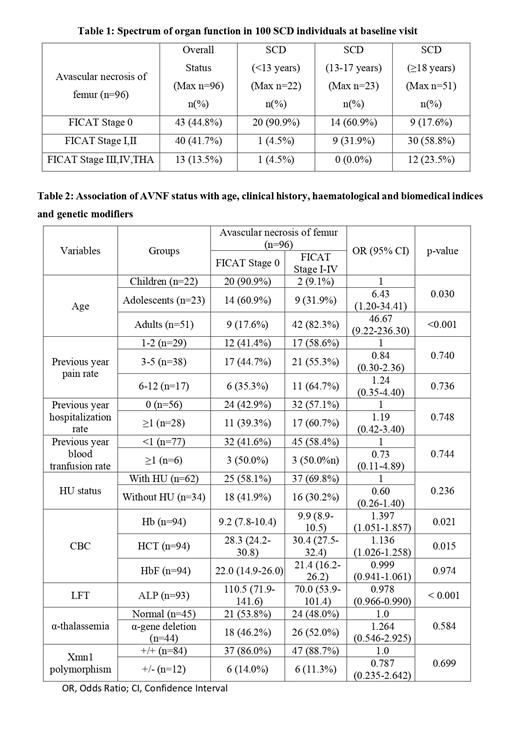Introduction:
Sickle cell disease (SCD) is one of the most common monogenic disorder world-wide and is a major health burden in India. Limited information is available on the prevalence of avascular necrosis (AVN) in Indian sickle cell patients. The present study focuses on understanding the prevalence of AVN of hip in patients with SCD and its correlation with different biochemical parameters and associated genetic modifiers.
Methodology:
SCD individuals at steady state with no blood transfusion prior to 3 months were recruited in the study after informed consent by a consecutive sampling for the study at ICMR-Centre for Research Management and Control of Haemoglobinopathies (ICMR-CRMCH), Chandrapur. All the clinical details including history and examination findings were noted. Laboratory evaluation included complete blood count, HPLC analysis, liver function test (LFT) and renal function tests and genetic modifiers including alpha-gene deletion and XMN polymorphisms. MRI and X-ray of both hip joints was performed for diagnosis of AVN.
Results:
One hundred SCD individuals (44 males: 56 females) were enrolled in the study. The median age of individuals was 18 years (IQR: 13-29 years). Individuals were categorized into three groups based on their ages. Children group (6-12 years): 23years, adolescents group (13-17 years): 23 individuals, and Adults (18-52 years): 54 individuals. Sixty five individuals were on drug hydroxyurea (HU), while remaining 35 were not taking HU. The median dosage of HU was found to be 11.9 mg/kg/day (IQR: 9.17-13.5 mg/kg/day).
The current study reports the spectrum of avascular necrosis of femur (AVNF) involving normal, early organ dysfunction to end organ damage as 43/96 (44.8%) FICAT stage 0, 40/96 (41.7%) AVNF stage I/II and 13/96 (13.5%) AVNF III/IV/Total hip anthroplasty (THA). The median age (interquartile range) of Ficat Stage 0, I-II and III-IV was found to be 13 (9-17) years, 24.5 (17.3-31.8) years and 23 (18-34) years respectively. Modified harris hip score for Ficat Stage 0, I-II and III-IV was found to be 84 (68-91), 72 (55.0-86.0) and 70 (38.0-89.5) respectively.
The mean ± standard deviation (S.D.) levels of hemoglobin (Hb) and HbF% were 9.7±1.6 gm/dl and 21.2±6.6% respectively. SCD individuals who were on drug HU therapy showed higher levels of Hb and HbF% levels, compared to those without HU therapy (p=0.03). Levels of Hb and hematocrit were positively associated with AVNF progression. HbF levels showed no association with AVNF stages. Levels of alkaline phosphatase (ALP) showed negative association with AVNF stages.
Genetic modifiers such as α-thalassemia and Xmn1 polymorphism showed no association with present status of AVNF.
Conclusion
AVNF is frequent complication of SCD leading to significant morbidity especially in young adults. AVNF was more frequent with higher haematocrit, but did not show correlation with HbF levels, α- gene deletion, XMN polymorphism and HU therapy. More research needs to be focused on prevention of AVN.
Disclosures
No relevant conflicts of interest to declare.


This feature is available to Subscribers Only
Sign In or Create an Account Close Modal